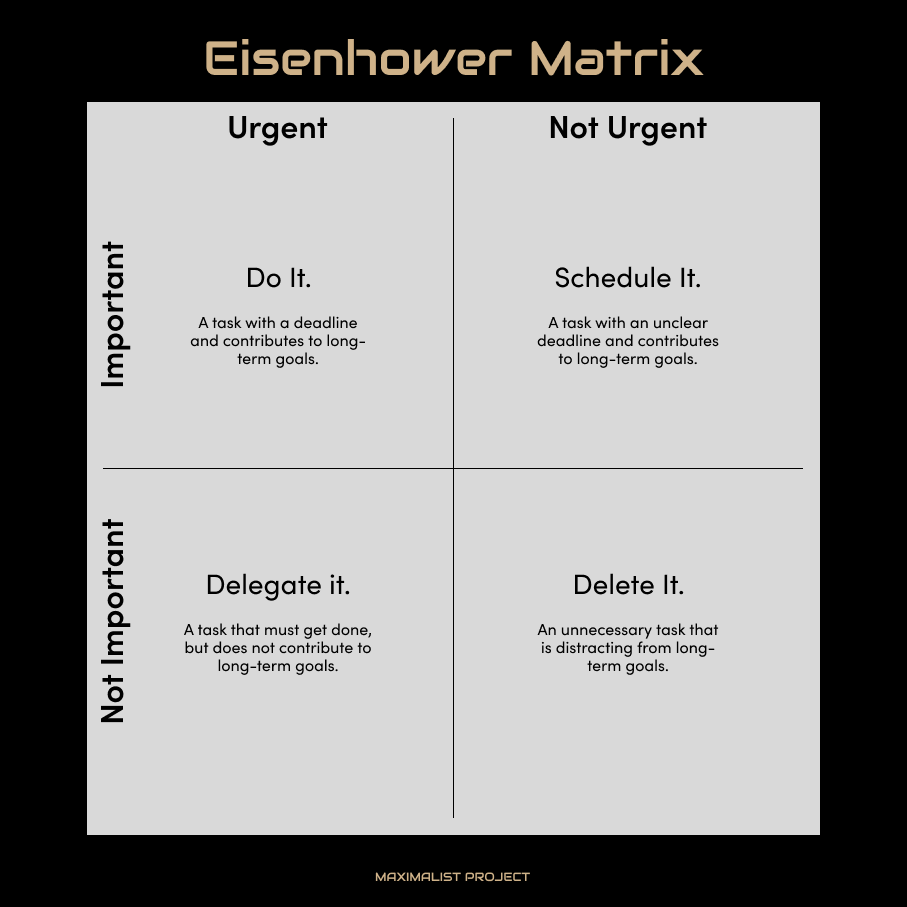Eisenhower Matrix: Prioritize Like a President
President Dwight D. Eisenhower, a five-star general during World War II and the 34th President of the United States, was well known for his decision-making skills. As someone who frequently…

President Dwight D. Eisenhower, a five-star general during World War II and the 34th President of the United States, was well known for his decision-making skills.
As someone who frequently needed to make decisions of supreme consequence, often under duress, it makes sense he would need a sound process for managing his time and energy.
He developed the Urgent-Important Matrix, or what would be called the Eisenhower Matrix, to help him prioritize tasks by urgency and importance and make efficient use of his time.
Today, the Eisenhower Matrix is widely used in business and personal time management, helping individuals prioritize their tasks and achieve greater efficiency and productivity.
What is the Eisenhower Matrix?
The Eisenhower Matrix is a time management and task management tool that helps individuals prioritize tasks based on their importance and urgency.
There are four quadrants in the Eisenhower Box:

Why It Works:
The Eisenhower Matrix, though a simple tool, is a powerful tool for time management for several reasons:
- It’s simple but powerful. The Eisenhower Matrix only requires you to answer two questions for each task, but they are the two most important questions you can ask when reviewing your task list: Is it important? Is it urgent?
- It creates absolute clarity. Ambiguity kills productivity, and there is no ambiguity in the Eisenhower Matrix. Yes/no questions ensure every task fits squarely into one of the four quadrants, and each quadrant has a specific, non-overlapping action for you to take.
- It’s effective in any context. It doesn’t matter if you are using it to sort your personal to-do list or run the United States of America. Importance and urgency will always be the driving force behind effective prioritization, making the Eisenhower Matrix infinitely applicable.
- It places the focus on important rather than urgent. Important tasks that support long-term goals are prioritized, even if they are not urgent, helping you avoid getting caught up in the immediacy of less important tasks.
- It reduces decision fatigue. Frameworks are simply shortcuts to better, more predictable outcomes and conclusions. The Eisenhower Matrix helps you quickly cut through a task list to determine what is important and actionable without the need to get into the weeds of each specific task. Less entanglement with unimportant tasks leaves more time and brainpower for what is truly important.
These are just a few reasons why the Eisenhower Matrix is an effective tool for time management and productivity. By using this method, individuals can take control of their schedules, focus on what matters most, and achieve greater success in their personal and professional lives.
How To Implement the Eisenhower Matrix
Implementing the Eisenhower Matrix is a straightforward process.
You can adapt it to handle all types of tasks and to fit your specific needs and preferences by determining how you define urgent and important. It also pairs well with the Eat the Frog Method for completing your to-do list and time blocking for managing your daily schedule.
Here are the basic steps:
- Make a list of tasks you must complete, including everyday tasks, important tasks, time-sensitive tasks, non-urgent tasks, etc.
- Go through your task list and assign each task to one of the four quadrants of the matrix:
- Quadrant 1: Important and urgent (tasks that need to be done immediately)
- Quadrant 2: Important but not urgent (tasks that are important but not time-sensitive)
- Quadrant 3: Not important but urgent (tasks that are time-sensitive but not important)
- Quadrant 4: Not important and not urgent (tasks that are neither important nor time-sensitive)
- Prioritize your tasks based on their quadrant, with tasks in the important and urgent quadrant being the highest priority.
- Schedule time in your calendar to complete the tasks in each quadrant, starting with the highest priority tasks.
- Review and update your matrix regularly to ensure you are prioritizing tasks effectively, eliminating unnecessary tasks, and making progress toward your goals.
- Be flexible and adaptable, as priorities may change over time.
By following these steps, you can effectively implement the Eisenhower Matrix and start prioritizing your tasks like a president.
Be honest with yourself when categorizing tasks, as it’s easy to overestimate the importance of certain tasks or underestimate the urgency of others.
With practice, you’ll become more skilled at using the matrix to eliminate time-wasting activities and achieve greater productivity and success in your work and personal life.





